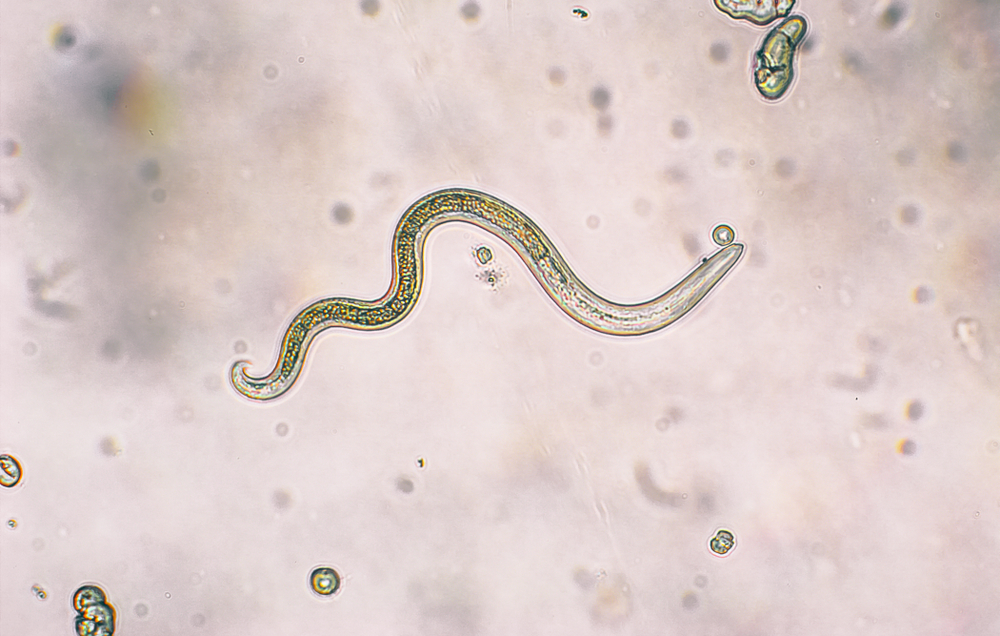Your cart is currently empty!
Man Develops ‘Pork Worms’ in His Brain After Years of Doing This Specific Cooking Habit

Breakfast lovers might want to reconsider their morning routine after learning about one man’s harrowing medical ordeal. A 52-year-old American developed a condition so rare that doctors initially couldn’t explain how he contracted it in the United States. His case would eventually challenge everything medical professionals thought they knew about domestic food safety.
For years, he had maintained the same breakfast habits, never imagining that his cooking preferences were slowly creating conditions for a parasitic invasion. When excruciating migraines began disrupting his life, medical scans would reveal something living inside his brain tissue, dozens of cysts containing creatures that should never have survived there.
What started as a simple preference for how he liked his bacon cooked would become a cautionary tale about the hidden dangers lurking in everyday kitchen choices. His story serves as a stark reminder that even common breakfast foods can harbor life-threatening risks when preparation methods go wrong.
Mystery Migraines Lead to Shocking Brain Discovery
Morning headaches had become a familiar companion for the unnamed 52-year-old patient, but something had changed dramatically over four months. His usual migraine medications, which had provided relief for years, suddenly stopped working entirely.
Weekly migraines escalated into severe episodes that conventional treatments couldn’t touch. Pain spread across the back of his skull with an intensity that forced him to seek emergency medical attention. What began as manageable discomfort had transformed into debilitating agony.
Medical professionals recognized immediately that his symptoms had evolved beyond typical migraine patterns. Years of successful treatment with standard medications suggested an underlying condition had developed, creating new neurological complications.
Emergency room physicians documented his vital signs as normal, ruling out immediate cardiac or respiratory causes. However, the persistence and severity of his symptoms demanded more comprehensive diagnostic procedures.
His case presented a medical puzzle that would require advanced imaging technology to solve. Standard headache protocols proved inadequate for determining the root cause of his escalating neurological symptoms.
Brain Scans Reveal Disturbing Cyst-Like Lesions
CT scan results shocked medical staff who examined the images. Numerous cyst-like formations appeared scattered throughout both hemispheres of the patient’s brain, creating a pattern unlike anything typically seen in routine neurological cases.
White matter regions, which contain the insulated wiring that connects brain cells, showed multiple abnormal growths. Each lesion appeared distinct yet part of a larger infestation pattern that suggested systematic invasion of neural tissue.
MRI imaging confirmed the CT findings while revealing additional complications. Fluid accumulation surrounded many of the cysts, indicating inflammatory responses that could cause dangerous brain swelling and pressure increases.
Neurosurgical consultation became necessary immediately as medical teams recognized the potential for life-threatening complications. Brain lesions of this type and distribution required specialist evaluation to determine appropriate treatment approaches.
Medical staff prepared for emergency intervention while conducting additional tests to identify the underlying cause. Multiple cyst formations in brain tissue typically indicate infectious processes that require immediate medical attention.
Tapeworm Larvae Found Living Inside Brain Tissue

Infectious disease specialists took control of the case after neurosurgeons identified the likely parasitic nature of the brain lesions. Blood testing would provide definitive answers about the organisms living inside the patient’s neural tissue.
Laboratory analysis detected antibodies against Taenia solium, a tapeworm species commonly found in pigs. “The patient was immediately admitted to the hospital for a neurosurgical consultation,” medical records documented as the severity of his condition became clear.
Parasitic larvae had successfully invaded brain tissue and established themselves within protective cysts. Each formation contained developing tapeworm organisms that were consuming neural resources while avoiding immune system detection.
Neurocysticercosis, the medical term for tapeworm larvae in brain tissue, represents one of the most serious parasitic infections affecting the central nervous system. Left untreated, the condition can cause permanent neurological damage or death.
Medical teams faced the challenge of eliminating parasites while minimizing damage to surrounding healthy brain tissue. Treatment protocols required a careful balance between anti-parasitic effectiveness and patient safety.
Lifelong Bacon Habit Identified as Likely Culprit
Medical interrogation focused on identifying potential exposure sources that could explain the patient’s parasitic brain infection. Travel history revealed no recent visits to regions where Taenia solium infections commonly occur.
His only international travel involved a cruise to the Bahamas two years earlier, where tapeworm exposure would have been extremely unlikely. Domestic infection sources require investigation since the parasite rarely appears in American food supplies.
Extended questioning revealed crucial information about his dietary habits that had persisted throughout his adult life. “Upon further questioning, the man admitted to a habit of eating lightly cooked, non-crispy bacon for most of his life,” case reports documented.
Medical professionals identified his “lifelong preference for soft bacon” as the probable infection source. Years of consuming undercooked pork products had created repeated opportunities for parasitic exposure and establishment.
Food safety guidelines recommend cooking pork to a minimum internal temperature of 145°F, but bacon’s thin profile makes temperature monitoring difficult. Crispy cooking ensures safe temperatures, while soft bacon may remain undercooked in critical areas.
Medical Team Solves Infection Pathway Mystery

Understanding how tapeworm larvae reached brain tissue required tracing the infection’s progression through multiple stages. Initial pork consumption likely caused intestinal tapeworm establishment, creating conditions for secondary self-infection.
Taeniasis, the intestinal form of tapeworm infection, occurs when people consume undercooked pork containing parasitic larvae. Adult tapeworms develop in the digestive system and begin producing eggs that pass through fecal waste.
“Someone with a tapeworm can infect him – or herself [autoinfection]” through poor hygiene practices, medical literature explains. Inadequate handwashing after bathroom use can transfer tapeworm eggs to food or directly into the mouth.
Autoinfection allows tapeworm eggs to hatch in the stomach and migrate through the bloodstream to various tissues, including the brain. Larvae cross the blood-brain barrier and establish cyst formations that protect them from immune responses.
Medical experts concluded that improper handwashing practices following bathroom visits had enabled the patient to repeatedly expose himself to his own parasitic waste products over extended periods.
Intensive Treatment Required to Save Patient’s Life
Parasitic brain infections require aggressive medical intervention to prevent permanent neurological damage or death. Anti-parasitic medications must eliminate tapeworm larvae while anti-inflammatory drugs control tissue swelling and immune responses.
Intensive care monitoring became necessary as treatment progressed through multiple weeks of hospitalization. Brain swelling from dying parasites and inflammatory responses can cause dangerous pressure increases that threaten vital brain functions.
Medical teams balanced parasitic elimination against potential treatment complications that could harm healthy brain tissue. Killing large numbers of larvae simultaneously can trigger massive inflammatory responses that damage surrounding neural structures.
Patient response to treatment required careful monitoring through repeated imaging studies and neurological assessments. Recovery progress depended on successful parasite elimination without causing additional brain damage.
Hospital discharge occurred only after medical teams confirmed treatment success and patient stability. Outpatient follow-up care continued to monitor long-term recovery and prevent complications.
Successful Recovery Despite Serious Brain Infection

Medical intervention proved effective despite the severity of the patient’s parasitic brain infection. Treatment protocols successfully eliminated tapeworm larvae while preserving essential brain functions throughout the recovery process.
Migraine symptoms improved significantly as parasitic cysts resolved and brain inflammation decreased. Pain management became possible again using conventional medications that had previously proven ineffective.
Follow-up imaging studies confirmed successful lesion regression and reduced brain swelling. Neural tissue showed healing patterns consistent with effective parasite elimination and healthy recovery processes.
Medical case reports documented positive outcomes: “The patient was successfully treated, with regression of lesions and improvement of headaches.” Long-term prognosis appeared favorable given the patient’s response to treatment.
Complete recovery from neurocysticercosis represents a medical success story that demonstrates the effectiveness of prompt diagnosis and appropriate treatment protocols for parasitic brain infections.
Proper Pork Cooking Temperature Guidelines Ignored
Food safety protocols exist specifically to prevent parasitic infections from undercooked pork products. Federal guidelines establish minimum cooking temperatures that eliminate dangerous organisms while preserving food quality.
FDA recommendations specify cooking pork to internal temperatures of at least 145°F to destroy parasitic larvae and bacterial contamination. Temperature monitoring using meat thermometers provides reliable safety verification.
Bacon presents unique challenges due to its thin profile, which makes internal temperature measurement difficult. However, cooking until crispy ensures adequate heat penetration that eliminates parasitic risks.
Cold bacon fat renders more slowly than surrounding meat tissue, creating uneven heating patterns that can leave dangerous organisms alive. Room temperature resting before cooking promotes more uniform heat distribution.
Food safety experts recommend allowing bacon to reach room temperature for approximately 15 minutes before cooking to ensure even heating throughout the meat’s thickness.
Taenia Solium Tapeworm: A Global Health Threat

Pork tapeworms represent significant public health challenges in regions where pig farming practices allow contamination with human waste. Poor sanitation creates conditions where pigs consume infected fecal matter and develop intestinal parasites.
Endemic regions, including Central and South America, Africa, and Asia, report thousands of neurocysticercosis cases annually. Rural areas with free-roaming pigs and limited sanitation infrastructure face the highest infection rates.
Neurocysticercosis serves as the leading cause of epilepsy in many developing nations where parasitic brain infections affect large populations. Limited medical resources complicate treatment and prevention efforts in affected areas.
World Health Organization data indicate that approximately 2,000 neurocysticercosis cases occur annually in the United States, primarily among travelers returning from endemic regions.
Immigration patterns bring infected individuals to areas where medical professionals may lack experience diagnosing and treating parasitic brain infections, creating diagnostic challenges for healthcare systems.
Rare US Case Raises Public Health Concerns
American pork production systems typically prevent tapeworm contamination through rigorous testing and sanitation protocols. Industrial farming practices separate pigs from human waste sources that enable parasitic transmission.
Medical literature describes tapeworm-infected pork as “historically very unusual to encounter” in United States food supplies. Domestic cases usually involve imported products or travel-related exposures rather than local contamination.
Case study authors noted significant implications for public health surveillance: “It is historically very unusual to encounter infected pork in the United States, and our case may have public health implications.”
Food safety agencies may need to investigate potential sources of contaminated pork products that enabled domestic infection without international travel. Supply chain analysis could reveal gaps in current testing protocols.
Consumer education about proper pork cooking techniques becomes essential as rare domestic cases demonstrate that infection risks exist even within regulated food systems.
Prevention Tips for Safe Bacon Consumption

Room temperature resting before cooking helps ensure even heat distribution throughout bacon strips. Cold meat from refrigeration creates uneven cooking patterns that may leave dangerous organisms alive.
Fifteen-minute resting periods allow fat rendering to occur more uniformly, promoting consistent internal temperatures throughout the meat’s thickness. Extended room temperature exposure beyond two hours creates bacterial contamination risks.
Crispy cooking provides visual confirmation that adequate temperatures have been reached throughout the bacon. Soft or chewy textures may indicate insufficient heating that preserves parasitic organisms.
Proper handwashing after handling raw pork products prevents cross-contamination and autoinfection risks. Thorough soap washing eliminates parasitic eggs that could transfer to food or eating surfaces.
Kitchen hygiene practices should include separate cutting boards for raw pork products and careful cleaning of all surfaces that contact uncooked meat.
Medical Mystery Highlights Food Safety Importance
Publication in the American Journal of Case Reports ensures that medical professionals worldwide learn about this unusual domestic neurocysticercosis case. Educational value extends beyond individual patient care to broader public health awareness.
Case documentation serves as a warning about seemingly minor food safety violations that can produce major health consequences. Breakfast preferences that seem harmless may harbor serious risks when proper cooking techniques are ignored.
Medical communities benefit from understanding how common cooking habits can lead to rare but serious parasitic infections. Diagnostic awareness helps physicians recognize unusual presentations of tropical diseases in domestic settings.
Food safety education programs should emphasize the importance of proper meat cooking techniques and personal hygiene practices that prevent parasitic transmission. Consumer awareness prevents tragic cases like this patient’s brain infection.
